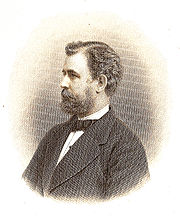
Carl Snoilsky
Encyclopedia

Sweden
Sweden , officially the Kingdom of Sweden , is a Nordic country on the Scandinavian Peninsula in Northern Europe. Sweden borders with Norway and Finland and is connected to Denmark by a bridge-tunnel across the Öresund....
lyric poet, known for his realist
Literary realism
Literary realism most often refers to the trend, beginning with certain works of nineteenth-century French literature and extending to late-nineteenth- and early-twentieth-century authors in various countries, towards depictions of contemporary life and society "as they were." In the spirit of...
poetry
Poetry
Poetry is a form of literary art in which language is used for its aesthetic and evocative qualities in addition to, or in lieu of, its apparent meaning...
.
Snoilsky was born in Stockholm
Stockholm
Stockholm is the capital and the largest city of Sweden and constitutes the most populated urban area in Scandinavia. Stockholm is the most populous city in Sweden, with a population of 851,155 in the municipality , 1.37 million in the urban area , and around 2.1 million in the metropolitan area...
. He was educated at the Clara School and Stockholms lyceum
Stockholms Lyceum
Stockholms lyceum was a private secondary school in Stockholm, Sweden, functioning from 1839 until 1875.The Lyceum was opened in 1839 by Claes Olof Ramström. He transferred the school in 1851 to Dr Carl Johan Bohman and Dr Otto von Feilitzen, who ran the school until 1875, when it was merged with...
and in 1860 became a student at the University of Uppsala. He was trained for diplomacy, which he quit for work at the Swedish Foreign Office. As early as 1861, under the pseudonym of Sven Tröst, he began to print poems, and he soon became the center of the brilliant literary society of the capital. In 1862 he published a collection of lyrics called Orchideer ("Orchids"). During 1864 and 1865 he was in Madrid
Madrid
Madrid is the capital and largest city of Spain. The population of the city is roughly 3.3 million and the entire population of the Madrid metropolitan area is calculated to be 6.271 million. It is the third largest city in the European Union, after London and Berlin, and its metropolitan...
and Paris
Paris
Paris is the capital and largest city in France, situated on the river Seine, in northern France, at the heart of the Île-de-France region...
on diplomatic missions. It was in 1869, when he first collected his Dikter under his own name, that Snoilsky took rank among the most eminent contemporary poets. His Sonneter in 1871 increased his reputation. Then, for some years, Snoilsky abandoned poetry, and devoted himself to the work of the Foreign Office and to the study of numismatics
Numismatics
Numismatics is the study or collection of currency, including coins, tokens, paper money, and related objects. While numismatists are often characterized as students or collectors of coins, the discipline also includes the broader study of money and other payment media used to resolve debts and the...
.
In 1876, however, he published a translation of the ballad
Ballad
A ballad is a form of verse, often a narrative set to music. Ballads were particularly characteristic of British and Irish popular poetry and song from the later medieval period until the 19th century and used extensively across Europe and later the Americas, Australia and North Africa. Many...
s of Goethe
Johann Wolfgang von Goethe
Johann Wolfgang von Goethe was a German writer, pictorial artist, biologist, theoretical physicist, and polymath. He is considered the supreme genius of modern German literature. His works span the fields of poetry, drama, prose, philosophy, and science. His Faust has been called the greatest long...
. Snoilsky had in 1876 been appointed keeper of the records (expeditionssekreterare) in the Foreign Office, and had succeeded Bishop Paul Genberg as one of the eighteen of the Swedish Academy
Swedish Academy
The Swedish Academy , founded in 1786 by King Gustav III, is one of the Royal Academies of Sweden.-History:The Swedish Academy was founded in 1786 by King Gustav III. Modelled after the Académie française, it has 18 members. The motto of the Academy is "Talent and Taste"...
. But in 1879 he resigned all his posts, and left Sweden abruptly for Florence
Florence
Florence is the capital city of the Italian region of Tuscany and of the province of Florence. It is the most populous city in Tuscany, with approximately 370,000 inhabitants, expanding to over 1.5 million in the metropolitan area....
with the Dowager Countess Ebba Piper, née Baroness Ruuth, whom he married in 1880. Count Snoilsky sent home in 1881 a volume of Nya Dikter ("New Poems"). Two other volumes of Dikter appeared in 1883 and 1887, and 1897; Savonarola, a poem, in 1883, and Hvitafrun ("The White Lady") in 1885. In 1886 he collected his poems dealing with national subjects as Svenska bilder (2nd ed., 1895), which ranks as a Swedish classic. In 1891 he returned to Stockholm and was appointed principal librarian (överbibliotekarie) of the Royal Library
Swedish Royal Library
The National Library of Sweden is the national library of Sweden. As such it collects and preserves all domestic printed and audio-visual materials in Swedish, as well as content with Swedish association published abroad. Being a research library, it also has major collections of literature in...
. He died at Stockholm on May 19, 1903.
His literary influence in Sweden was very great; he always sang of joy and liberty and beauty, and in his lyrics, more than in most modern verse, the ecstasy of youth finds expression. He is remarkable, also, for the extreme delicacy and melodiousness of his verse-forms. His Samlade dikter were collected (Stockholm, 5 vols.) in 1903–1904.

